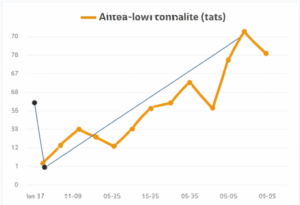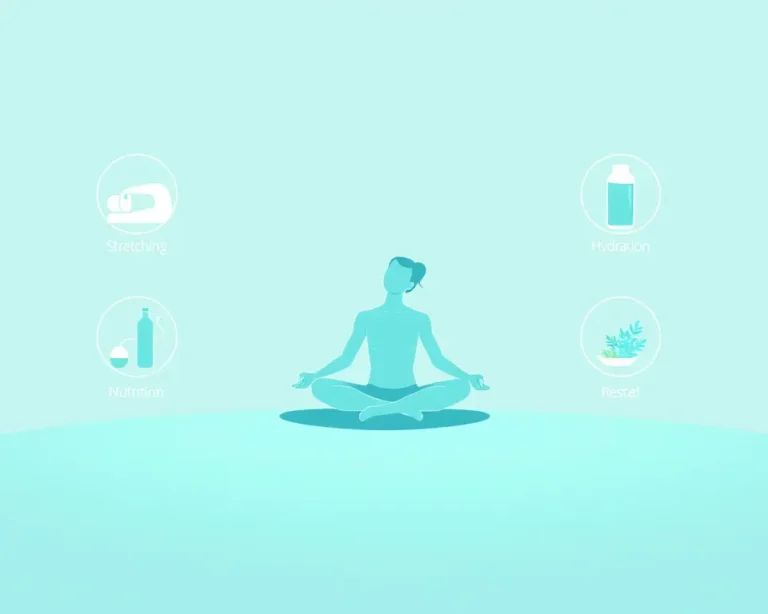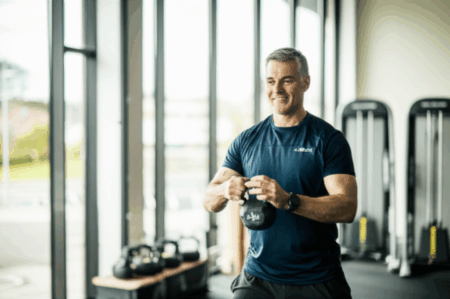That satisfying burn after a tough workout can quickly turn into an unwelcome ache. Muscle soreness, especially Delayed Onset Muscle Soreness (DOMS), typically kicks in 24-48 hours after exercise, leaving you feeling stiff and uncomfortable. DOMS is caused by microscopic tears in your muscle fibers as a result of high intensity exercise. Fortunately, a proactive approach can significantly reduce post-workout soreness and get you back to feeling your best.
Here’s a simple yet effective 4-step routine to help you conquer muscle soreness and optimize your recovery:
1. Cool Down and Static Stretching
The immediate aftermath of your workout is crucial for initiating recovery. Don’t just abruptly stop your exercise; instead, dedicate time to a proper cool-down.
- Why it works: A cool-down helps your heart rate gradually return to its resting rate.
- How to do it: Include 5-10 minutes of low-intensity activity, such as light jogging, walking, or cycling.
- Stretching: Follow your cool-down with static stretches, holding each stretch for 20-30 seconds. Static stretches help lengthen the muscles and keep them from tightening up after a tough workout.
- Target areas: Focus on the muscles you worked during your exercise, as well as major muscle groups like your hamstrings, quads, calves, chest, and back.
- Dynamic stretching: Kinetic stretching, or warming up muscles with movement, is also beneficial and can be combined with static stretching for best results.
2. Refuel and Rehydrate
What you eat and drink after your workout plays a vital role in muscle repair and recovery.
- Protein: Your body needs protein to repair muscles. Aim for a post-workout meal or snack that includes a good source of protein to aid muscle recovery.
- Carbohydrates: Carbs will fuel your next workout.
- Healthy Fats: Healthy fats lubricate your joints.
- Examples: Some great foods to eat after you work out include protein and carbohydrates which tend to be great sources of fuel after catabolic exercises like endurance running and HIIT cardio. Protein and carbs are also great foods to eat after you work out after anaerobic exercises like weightlifting and strength training.
- Hydration: Dehydration is your enemy when it comes to muscle recovery. Replenish fluids lost through sweat by drinking plenty of water or electrolyte beverages. Hydration is always a priority before, during, and after a workout.
3. Active Recovery and Massage
Rest is important, but complete inactivity can sometimes hinder recovery. Active recovery, which involves low-intensity movement, can promote blood flow and reduce muscle stiffness. Gentle massage of the affected muscles can help to alleviate soreness and improve circulation. Foam rolling is a popular technique for self-massage that can help reduce muscle stiffness and soreness.
- Light exercise: Walking, light jogging, swimming, cycling, or yoga are all excellent choices for active recovery. Aim for an effort level of 3 on a scale of 0-10 (where 10 is maximum intensity).
- Foam rolling: Foam rolling has become a popular recovery technique. Think of it as a cheap way to give yourself a deep tissue massage. By slowing rolling over areas of tension, you can help release tight muscles and speed up the healing and recovery process. After your workout, spend 10 to 15 minutes using a foam roller before starting stretching exercises. When the muscle is more relaxed, you’ll be able to stretch it further than if it’s still contracted.
- Massage: Consider a professional massage or self-massage techniques to further alleviate muscle tension and improve blood flow. Many athletes incorporate massage in their training to reduce muscle soreness.
4. Prioritize Sleep and Rest
Sleep is often overlooked, but it’s during sleep that your body does the bulk of its repair work.
- Why it’s essential: Blood flow, tissue growth, and muscle repair all happen when we enter the deep stages of sleep.
- Aim for 7-9 hours: Make sure you’re getting some quality shut-eye the evening after your workout.
- Rest Days: Allow your body sufficient time to recover. This may involve taking a day off from intense exercise or focusing on different muscle groups to give the affected muscles time to heal.
Additional Tips for Soreness Reduction
Beyond the 4-step routine, consider these additional strategies to further minimize muscle soreness:
- Warm-up Properly: Before each workout, spend 5 to 10 minutes doing some dynamic stretching. An important part of protecting your muscles is making sure they’re primed for use before you challenge them.
- Epsom Salt Baths: Soaking in warm water with Epsom salts can help relax your muscles and relieve pain.
- Heat and Cold Therapy: Applying heat, such as a warm bath or heating pad, can help relax sore muscles. Cold therapy, such as ice packs or cold baths, can help reduce inflammation and alleviate pain.
- Compression Garments: Wearing compression garments can help reduce muscle soreness and fatigue.
- Anti-Inflammatory Foods: Tomatoes, olive oil, green leafy vegetables, nuts, fatty fish like salmon and tuna, and fruits (especially berries) have anti-inflammatory properties that help reduce muscle soreness.
- Over-the-Counter Pain Relief: If needed, consider using over-the-counter pain relievers to manage discomfort.
- Supplements: Consider supplements like BCAAs, creatine or magnesium if needed.
- Gradual Progression: Starting a new exercise routine demands patience and gradual increases in intensity. Giving them time to adapt can help limit the severity of your soreness. When starting a new workout routine or when upping the intensity, just be sure to do so slowly over the course of several days or weeks.
- Avoid NSAIDs: Research indicates that regularly taking non-steroidal anti-inflammatory drugs (NSAIDs) for DOMS may hinder this process, potentially reducing the muscle strength gains from your training.
By incorporating these strategies into your fitness routine, you can minimize post-workout soreness, optimize recovery, and achieve your fitness goals more effectively.







